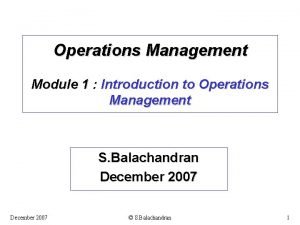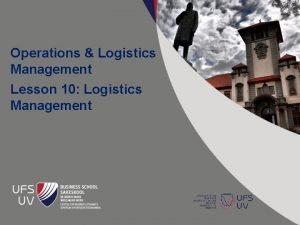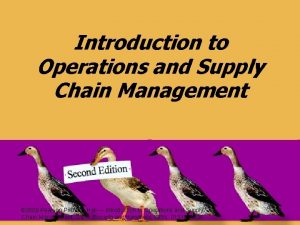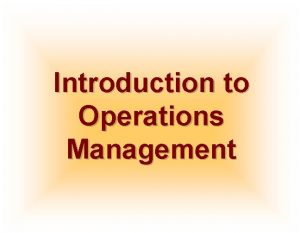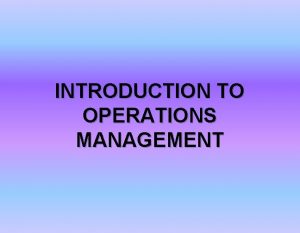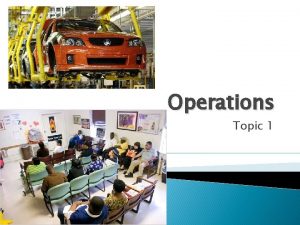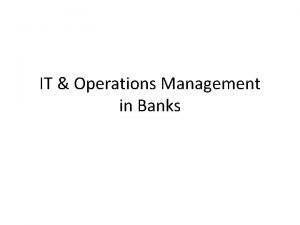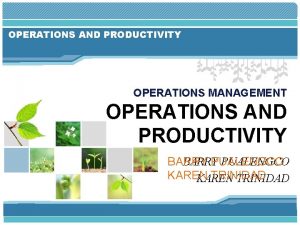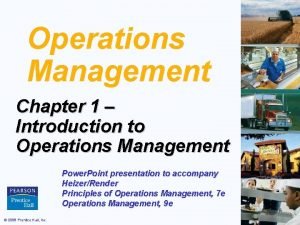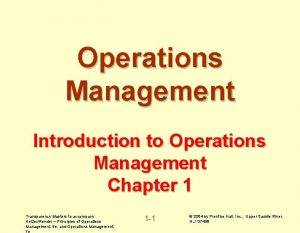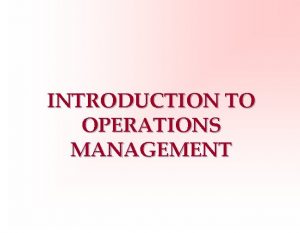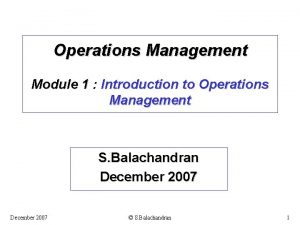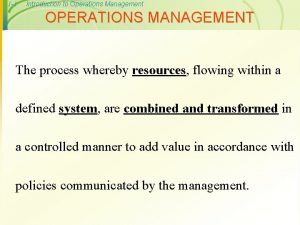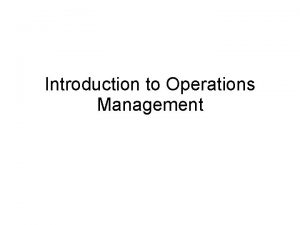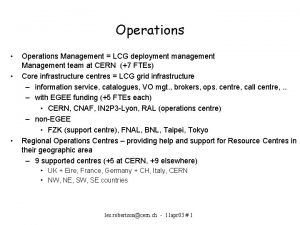Introduction to Operations Management Operations Management is The
















- Slides: 16

Introduction to Operations Management

• Operations Management is: The management of systems or processes that create goods and/or provide services • Operations Management affects: 1. Companies’ ability to compete 2. Nation’s ability to compete internationally

Organization Functions Organization Finance Operations Marketing

Value-Added Transformation Process The operations function involves the conversion of inputs into Value-Added outputs Inputs - Land - Labor - Capital Transformation process Outputs - Goods & Services Feedback Control Feedback

Goods-service Continuum Goods Service Surgery, teaching Software development RO Repair, hotel meal Automobile Repair, fast food Home remodeling, retail sales Automobile assembly, steel making

Goods vs Service Characteristic Customer contact Uniformity of input Labor content Uniformity of output Output Measurement of productivity Opportunity to correct problems Inventory Evaluation Patentable Goods Low High Tangible Easy High Much Easier Usually Service High Low Intangible Difficult Low Little Difficult Not usual

Scope of Operations Management • Operations Management includes: – Forecasting – Capacity planning – Scheduling – Managing inventories – Assuring quality – Motivating employees – Deciding where to locate facilities – Supply chain management – and more. . .

Historical Evolution of Operations Management 1. Industrial revolution (1770’s) 2. Scientific management (1911) 1. Mass production 2. Interchangeable parts 3. Division of labor 3. Human relations movement (1920 -60) 4. Decision models (1915, 1960 -70’s) 5. Influence of Japanese manufacturers

Trends in Business 1. 2. 3. 4. 5. 6. 7. The Internet, e-commerce, e-business Management technology Globalization Management of supply chains Outsourcing Agility Ethical behavior

Competitiveness and Operations Strategy

Competitiveness • Competitiveness refers to how effective an organization is in the competition for customers’ purchases – Primarily a function of how well the organization (through its operations) meets the needs of customers

Competitiveness : Bases for Competition Business organizations compete with one another in a variety of ways. These includes Fl ex Price Quality Di ffe ren ibi lit y Service tia tio n Time Managers and workers

Strategies – are the roadmaps ( action plans) for reaching the goals Operations Strategy is narrower in scope, dealing primarily with the shop floor operations aspect of the organization. Ørelates to Products, Processes, Methods, Operating Resources, Quality, Costs, Lead-Times and Scheduling. Operations strategy must be streamline it to organization strategy.

Processes 1. Project - One-time production of customised product 2. Job shop production - Process many variety jobs in small volume at same time in lot 3. Batch production - Process moderate variety jobs in moderate volume at same time in batch 4. Mass production – Produce small variety large volumes of standard product for mass market 5. Continuous production - Very high volume small variety commodity product

Product-Process Matrix High Continuous Production Volume Mass Production Batch Production Job shop Production Projects Low Standardization High

Examples of Distinctive Competencies Competency Price Low cost Quality High Performance design and/or high quality Consistent quality Time Rapid Delivery On-time Delivery Flexibility Variety Volume Service Superior customer service Location Convenience
 Operations management modules
Operations management modules Introduction to operations and supply chain management
Introduction to operations and supply chain management Operations management chapter 1
Operations management chapter 1 Introduction to operations and supply chain management
Introduction to operations and supply chain management Hát kết hợp bộ gõ cơ thể
Hát kết hợp bộ gõ cơ thể Frameset trong html5
Frameset trong html5 Bổ thể
Bổ thể Tỉ lệ cơ thể trẻ em
Tỉ lệ cơ thể trẻ em Chó sói
Chó sói Thang điểm glasgow
Thang điểm glasgow Chúa yêu trần thế
Chúa yêu trần thế Kể tên các môn thể thao
Kể tên các môn thể thao Thế nào là hệ số cao nhất
Thế nào là hệ số cao nhất Các châu lục và đại dương trên thế giới
Các châu lục và đại dương trên thế giới Cong thức tính động năng
Cong thức tính động năng Trời xanh đây là của chúng ta thể thơ
Trời xanh đây là của chúng ta thể thơ Cách giải mật thư tọa độ
Cách giải mật thư tọa độ
